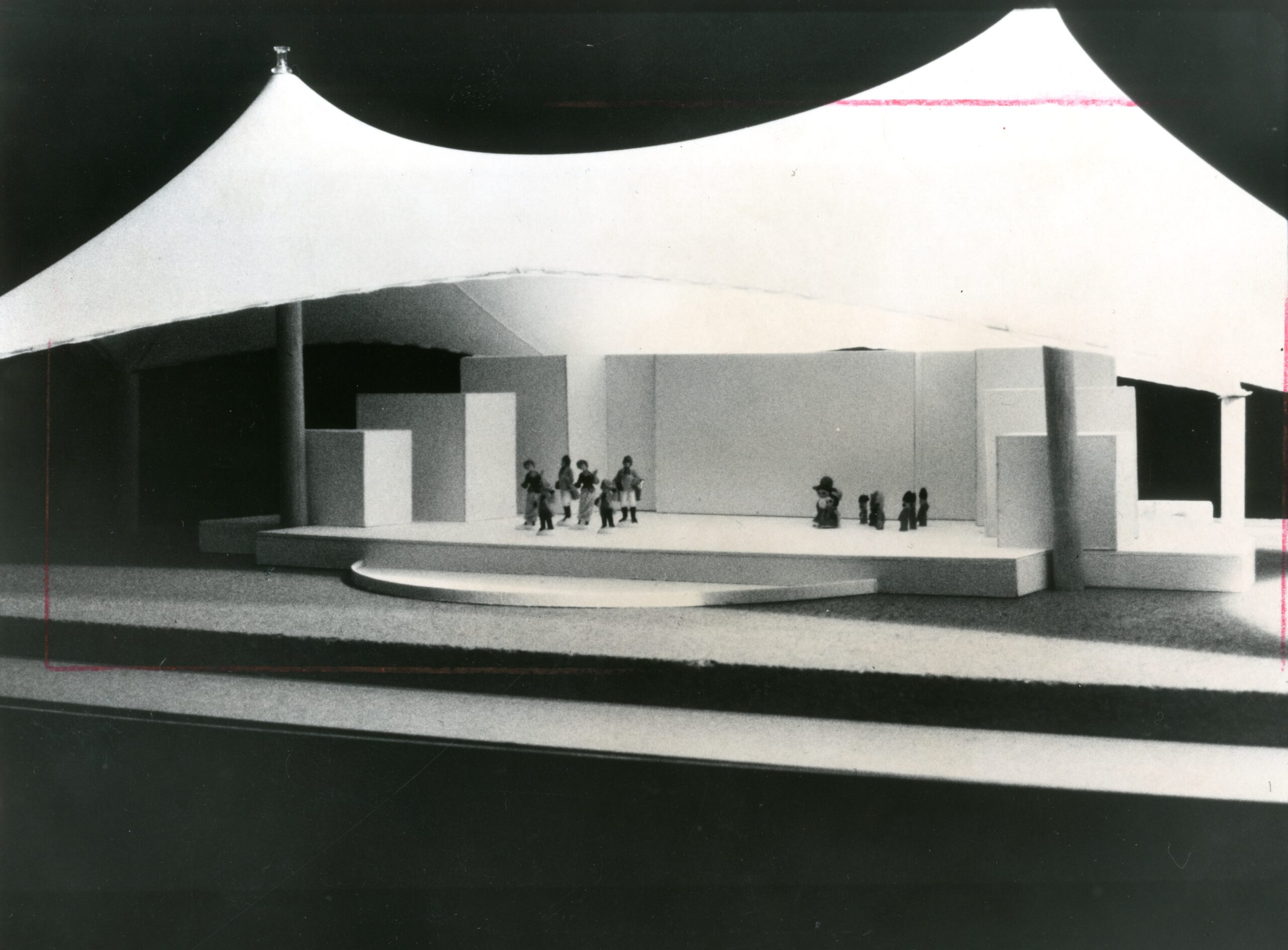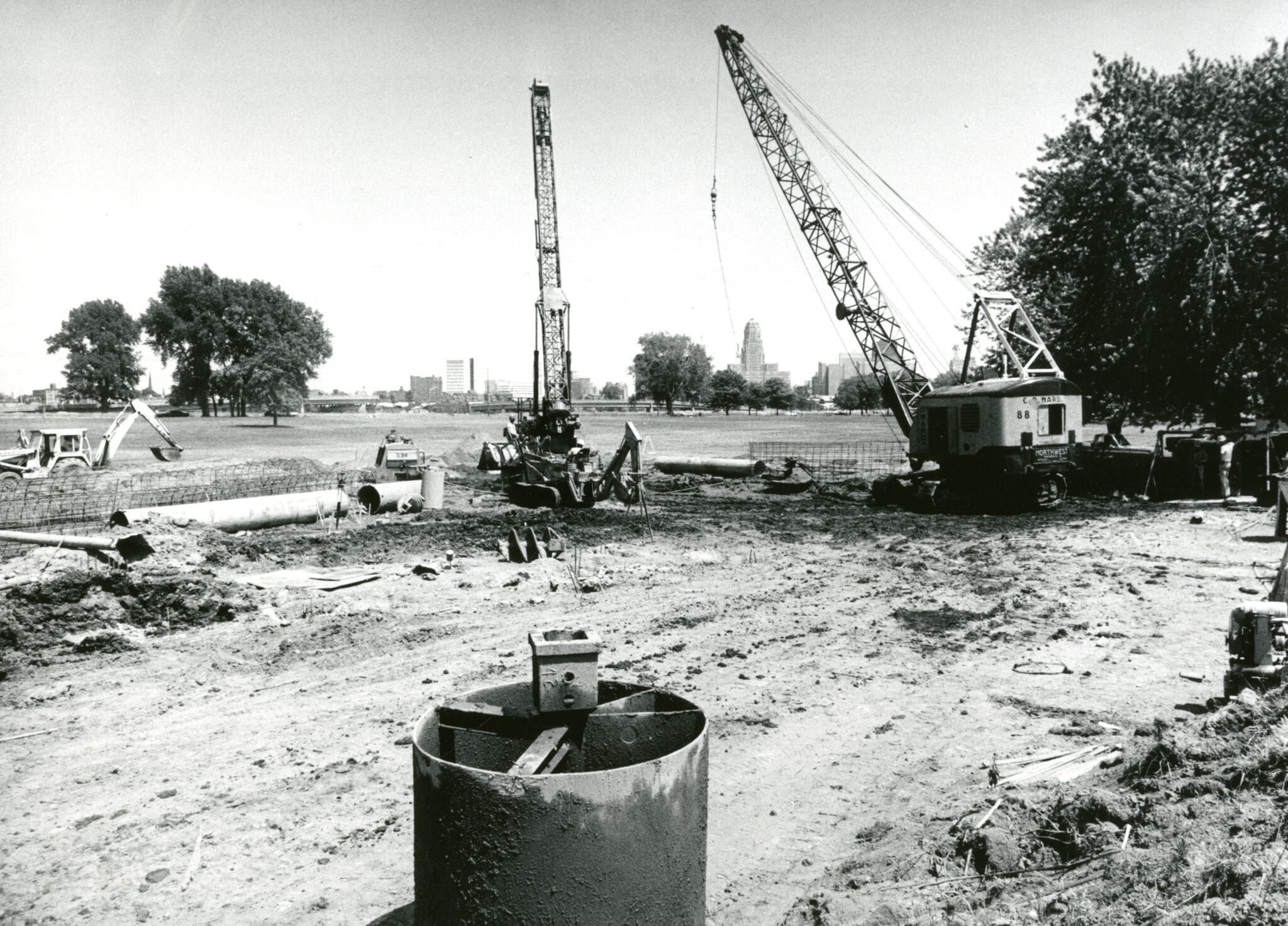
For 40 years, our park has housed an amphitheater. Built for waterfront entertainment, this performing arts structure is a part of the architectural heritage of this community greenspace. While many have seen this bandshell, few know its historical significance. Turns out, this tent-like structure was built by a Buffalo architectural legend. Birdair, and its founder Walter Bird, were the creators and champions of fabric structures, including the one in our park. Their work popularized domes, tents, and air-supported structures used for everything from sheltering the first northern superbowl to protecting military radar stations. As the conservancy works to save this venue, we’ve enjoyed exploring (and now sharing) this piece of architectural heritage at the park.
Walter Bird and the History of his Birdair Company
Walter Bird is a Buffalo legend. Known internationally as the “father of permanent fabric structures”, Bird founded his Buffalo-based company Birdair in 1956. Fabric as a material in permanent building construction was relatively unheard of at this time. Bird changed that.
In the early days, Walter Bird and the Birdair company focused on designing fabric structures for military installations. Bird first made his mark designing ‘radomes’, inflatable fabric domes covering radar stations in North America. The use of fabric in an air-supported dome protected these military installations, but did not interfere with signal transmission. Hoping to expand into the consumer market, Birdair went on to advertise other uses for their fabric and air-supported designs. Historical advertisements archived at the University of Buffalo show Birdair pool domes selling the possibility of year-round swimming in cold climates and fabric storage units you can pop up anywhere.
In the early years Bird’s company stayed small. There was a reluctance by many to invest in buildings made from fabric. Likewise, the idea of an air-supported structure raised concerns. Bird had to prove his bubble-like creations could withstand wind, rain, and heavy snow. He needed to prove they had longevity and were not limited to small structures. As time went on, Bird was able to prove all of this and more.
Throughout the 1970s and 1980s, Birdair designs got bigger and bolder. The company eventually broke into the stadium world. Syracuse University’s 50,000 seat Carrier Dome as well as Pontiac, Michigan’s 80,000 seat Silverdome were two of the first Birdair stadium projects. In 1982, the Silverdome used their protective fabric roof to host the first Super Bowl in a northern city, adding significant credibility to what Birdair could achieve. Then Bird went bigger. After success in the stadium world, Birdair was behind an airport terminal in Saudi Arabia over 4 million square feet in size, showing just how huge an air-supported structure could be.
Despite these successes, Bird was yet to make an extensive mark at home in Buffalo. The 1970’s inflatable athletic center University at Buffalo students called “The Bubble” was a Birdair, but few other WNY contracts came in. A 1982 Business & Industry article reported a lack of local enthusiasm for his product. Walter Bird would eventually win over the region that housed the company’s headquarters, however. Birdair went on to construct more fabric and air-supported structures throughout WNY, including the tensioned membrane skylights at the Walden Galleria mall and our park’s amphitheater.
By the late 1980s and 1990s Birdair had convinced the world of the value of fabric structures. They were building everything from airports, to athletic facilities, to zoo enclosures. They worked internationally, adding air-supported structural elements to the Museum of Science and Technology in France, the Olympic Stadium in Italy, and the Air Force Peace Shield in Saudi Arabia.
Birdair was making its mark in the US as well. In 1989 it won the U.S. Space Foundation’s award for spin-off technology development, recognizing the company’s transformation of NASA space suit fabric into architectural fabric. Birdair was contracted for many memorable American fabric structures. Some examples include King Kong Highway at Orlando’s Universal Studios and internal parts of Spaceship Earth at Disney’s Epcot. Meanwhile, Walter Bird’s company was working on community-level projects as well. A school in Alaska, a church in Australia, a cafe in Mountain View, California, and a dance pavilion in Sioux City, Iowa, were all given a Birdair installation. Our own Birdair, the park’s amphitheater, has much in common with these examples. It may be part of a global architectural legend, but the park’s stage serves at a community-level. Since its completion in 1984, the bandshell has focused on entertaining everyday members of the Buffalo community.
Our Park Amphitheatre: Past
Historical records show that the building of the park amphitheater was a multi-year process. The structure was designed in 1981, still under construction when the photo below was taken in 1983, and listed in Birdair’s completed projects list in 1984. The project was a Buffalo collaboration. Not only was Buffalo-based Birdair behind it, the ampitheatre’s architect and general contractor firms were Buffalo firms (Hamilton, Houston, Lownie and Walden Builders) and they worked with an engineer from Williamsville (Joseph A. Siracuse).
Once complete, our park amphitheater was immediately put to work for the local community. News articles in July 1984 shared a stage filled with entertainment for the summer waterfront festival. The entertainers were from the Langston Hughes Institute. Our Birdair structure supported dancers, poets, and performers from this legendary artist-founded urban center that used access to art to improve social conditions. More community events followed. A Tribute to Scotland concert in 1986, the Commodores and Natalie Cole performances in 1990, and an Underground Railroad commemoration in 1995, all bringing people together under the airy, translucent, Birdair roof. From its inception, this stage was a dynamic community space.

Photo: the band shell under construction in June 1983. Collection of the Buffalo History Museum, General Photograph Collection, Parks – Buffalo and Erie County – Ralph C. Wilson Centennial Park
Our Park Amphitheatre: Present & Future
In the 40 years since the amphitheater was complete, the bandshell served the community. It continued its tradition of hosting music, supporting events of the Buffalo Funk Festival, now twenty years running, and the annual Puerto Rican and Hispanic Day Parade of WNY. The venue also provided space for other community events. In August 2019, a candlelight memorial service led by the Erie County Opiate Epidemic Task Force lit up the stage, reminding us that public gatherings for somber purposes are important to a community as well. The stage has sat in its location in LaSalle Park for decades. It was still standing when the decision was made to transform LaSalle into the new Ralph Wilson Park.
Photo: A recent picture showing the waterfront amphitheater in the park
When the plan to redesign the former LaSalle Park was announced, it wasn’t clear which parts of the existing park, including the bandshell, would remain. Despite continued use, this venue was not being utilized as much as it could have been. The Imagine LaSalle community group decided to keep the 40-year-old structure however, and breathe new life into Bird’s design. When the final park rendering was shared, the Birdair venue was still there. The airy, billowing roof will remain, gracing the shores of Lake Erie and ready for its next show.
Today, the Ralph Wilson Park Conservancy is actively working to make sure this piece of architectural heritage can serve the community for years to come inside the new park. The RWPC team is actively seeking support to upgrade the amphitheater and offer even more free music when the park reopens. Improvements to the land around the venue will make gathering in crowds more comfortable. And increased visitation sure to follow the grand reopening of the park will ensure any organization, artist, or community member who books the stage will have ample guests. The amphitheater is not merely remaining in place, it’s being given a new life.
Decades ago Walter Bird fought hard to prove fabric structures like our amphitheater had longevity. Forty years and an exciting future for one small Birdair project on Lake Erie is proof of his claim. After decades of serving the Buffalo community, this small piece of architectural heritage at the waterfront lives on, a vibrant piece of history with an even more vibrant future ahead of it.
Photo: the amphitheater featured in the new park’s final design.
Lead Photo: model of band shell that was installed in the former LaSalle Park in the 1980s, designed by Buffalo architects Hamilton Houston Lownie Architects, in collaboration with Birdair. Collection of The Buffalo History Museum. General photograph collection, Parks – Buffalo and Erie County – LaSalle.
All of the Heritage Engagement Project blog posts, written by Dr. Kathryn Grow Allen, are now in one spot. Check out our new HEP page for past and future reading on heritage-building at Ralph Wils on Park.









